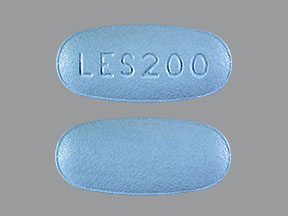Lesinurad Dosage
Applies to the following strengths: 200 mg
Usual Adult Dose for:
Additional dosage information:
Usual Adult Dose for Gout
200 mg orally once a day
Maximum dose: 200 mg per day
Comments:
- Coadminister with a xanthine oxidase inhibitor (e.g., allopurinol or febuxostat); if coadministered with allopurinol, total daily allopurinol doses should not be less than 300 mg (or less than 200 mg with CrCl less than 60 mL/min).
- If xanthine oxidase inhibitor is interrupted, this drug should also be interrupted.
- This drug should not be used to treat asymptomatic hyperuricemia.
Use: Add-on treatment for hyperuricemia associated with gout in patients with elevated serum uric acid despite treatment with a xanthine oxidase inhibitor
Renal Dose Adjustments
CrCl 45 mL/min or greater: No adjustment recommended.
CrCl less than 45 mL/min: Not recommended
CrCl less than 30 mL/min: Contraindicated
- For serum creatinine levels greater than 2 times pretreatment level: Interrupt therapy; do not restart without another explanation for serum creatinine abnormalities.
- If CrCl becomes persistently less than 45 mL/min during therapy, therapy should be discontinued.
Liver Dose Adjustments
Mild to moderate liver impairment (Child-Pugh A to B): No adjustment recommended.
Severe liver impairment (Child-Pugh C): Not recommended.
Precautions
US BOXED WARNING:
- ACUTE RENAL FAILURE: Increased frequency of acute renal failure observed when this drug was given as monotherapy. This drug should be used in combination with a xanthine oxidase inhibitor.
Safety and efficacy have not been established in patients younger than 18 years.
Consult WARNINGS section for additional precautions.
Dialysis
Contraindicated
Other Comments
Administration advice:
- Take orally once a day in the morning with food and water
- Take morning dose at same time as morning dose of xanthine oxidase inhibitor (XOI)
- Patients should stay well hydrated (e.g., 2 liters of liquid per day)
- If a dose is missed, skip the missed dose; do not double the dose.
- If XOI treatment is stopped, this drug should be stopped.
Storage requirements:
- Protect from light
General:
- This drug should not be used to treat asymptomatic hyperuricemia or as monotherapy.
- Gout flares may occur due to increased urate mobilization from tissue deposits, especially during initiation; gout flare prophylaxis is recommended according to practice guidelines.
- If gout flares occur during treatment, manage concurrently; discontinuation of this drug should not be necessary.
- This drug is not expected to be effective in patients with severe renal impairment, end stage renal disease, or on dialysis.
Monitoring:
- Serum creatinine levels should be obtained at baseline and periodically during treatment; in patients with CrCl of 45 to less than 60 mL/min or serum creatinine 1.5 to 2 times pretreatment levels, more frequent monitoring is advised.
- Serum creatinine should be promptly assessed in patients reporting signs/symptoms of acute uric acid nephropathy (e.g., acute flank pain, nausea, vomiting).
Patient advice:
- Instruct patients to keep well hydrated while using this drug (e.g., 2 L fluid per day).
- Inform patients that gout flares may occur, and they should not stop taking this drug if a gout flare occurs.
- Patients should be instructed to report signs/symptoms of acute nephropathy to health care provider.
- Patients should be advised to speak to healthcare provider if pregnant, intend to become pregnant, or are breastfeeding; patients using hormonal contraception to prevent pregnancy will need to speak with their health care provider about using a non-hormonal back-up method of birth control during therapy.
More about lesinurad
- Check interactions
- Compare alternatives
- Reviews (2)
- Side effects
- During pregnancy
- Drug class: antihyperuricemic agents
Patient resources
Other brands
Professional resources
Other brands
Related treatment guides
See also:
Further information
Always consult your healthcare provider to ensure the information displayed on this page applies to your personal circumstances.


